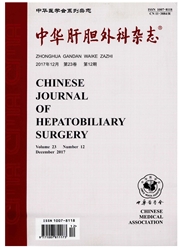

 中文摘要:
中文摘要:
目的制备VEGF靶向荷钆纳米探针,并研究其在小肝癌特异性成像中的价值。方法采用生物相容性高分子材料聚乳酸-聚乙二醇一聚赖氨酸(PLA—PEG-PLL)纳米粒为载体,分别将血管内皮生长因子(VEGF)抗体及钆基接合至载体表面得到靶向纳米探针。体外MR成像测定其驰豫率,再利用种植型H22肝癌小鼠模型进行靶向纳米探针MR增强扫描,探讨皮下种植肝癌及微小病灶的强化表现特点。结果制备的靶向探针粒径和Zata电位分别为(85.8±7.2)nm和(21.63±2.4)mV,当其浓度为8.0μmol/ml时测得的R1值为18.394mmol·ml-1·S-1。靶向探针MR增强扫描显示皮下较大肝癌及小肝癌均表现为明显的特异性靶向延迟期增强,强化峰值分别在2h及3h时出现,而非靶向纳米粒增强扫描时肿瘤强化不明显。结论成功制备了合适的高驰豫率VEGF靶向PLA—PEG-PLL荷钆纳米探针,并实现了小肝癌的特异性靶向成像。该纳米探针在肝癌检测方面具有较好的临床应用前景。
 英文摘要:
英文摘要:
Objective This study aims to synthesize a novel gadolinium loaded nanoprobe targe- ted to vascular endothelial growth factor (VEGF) and assess its clinical value for imaging micro hepat- ic carcinoma. Methods A carrier was made by the biocompatible polymer material polylactic acid-po- lyethylene glycol-poly-L-lysinenanoparticles (PLA-PEG-PLLs). The targeted nanoprobe was obtained with anti-VEGF antibody and gadolinium (Gd) bonding to the surface of the carrier. MRI in vitro de- termined the T1 relaxivity of the nanoprobe. A live cancer model enhanced MR scan was performed by injecting targeted nanoprobes into the tail vein of grafted H22 tumor mice. The enhanced characteris- tics of the subcutaneous tumors and micro-hepatic carcinoma were then reviewed. Results The parti- cle size of the VEGF-targeted PLA-PEG-PLL gadolinium loaded nanoprobe was 85.8± 7.2 nm with a zeta potential of 21.63±2.4 inV. The R1 relaxivity of the targeted nanoprobe was 18. 394 mmol/s at 3.0 T when its gadolinium concentration was 8.0 μmol/ml. The enhanced MR scan using targeted probes showed that the big and micro-subcutaneous cancer exhibited a specifically delayed enhancement with an enhanced peak value at 2 or 3 hours, rather than the enhancement of the tumor using the non- targeted nanoparticles. Conclusion In conclusion, the VEGF targeted PLA-PEG-PLL gadolinium loaded nanoprobe was synthesized successfully, showed a high relaxivity, achieved targeted imaging of the micro-hepatic carcinoma, and exhibits a promising potential in the detection of this liver cancer.
 同期刊论文项目
同期刊论文项目
 同项目期刊论文
同项目期刊论文
 期刊信息
期刊信息
